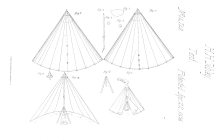
The Sibley tent was invented by the American military officer Henry Hopkins Sibley and patented in 1856. Of conical design, it stands about 12 feet (3.7 m) high and 18 feet (5.5 m) in diameter.[1] It can comfortably house about a dozen men.[2]
The Sibley design differed from other conical tents, or bell tents in a number of ways. Sibley's design is supported by a central pole that telescopes down into the supporting tripod so that it takes less space to pack and store. The tripod could be erected over a firepit for cooking and heat. The Sibley design also required no guy ropes, being held down by twenty-four pegs around the base.[1][3] Additionally, unlike earlier designs, the use of a cowl over the central pole allowed for ventilation and for the escape of smoke, regardless of wind direction.[4]
- ^ a b Sibley, "Conical Tent"
- ^ Marcy, The Prairie Traveler, p. 143: "The tent used in the army will shelter comfortably twelve men."
- ^ Marcy, The Prairie Traveler, p. 142-143: "A tent has been invented by Major H.H. Sibley, of the army, which is known as the "Sibley tent." It is somewhat similar to the Comanche lodge but, in place of the conical frame-work of poles, it has but one upright standard, resting upon an iron tripod in the centre. The tripod can be used to suspend cooking utensils over the fire and, when folded up, admits the wooden standard between the legs, thereby reducing the length by half, and making it more convenient for packing and traveling."
- ^ Harrington, A Manual of Practical Hygiene, p. 601: "The English army uses the circular, or bell, tent. ... Formerly, the ventilation was practically nil, but now it has been somewhat improved."